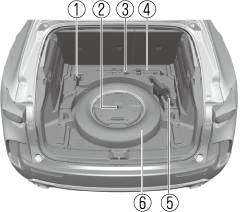Flat Tire
Spare Tire and Tool Storage
Spare tire and tools are stored in the locations illustrated in the diagram.

-
Tiedown eyelet (Some Models)
-
Spare tire hold-down bolt
-
Jack lever
-
Lug wrench
-
Jack
-
Spare tire
Spare Tire
Your Mazda has a temporary spare tire.
The temporary spare tire is lighter and smaller than a conventional tire, and is designed only for emergency use and should be used only for VERY short periods. Temporary spare tires should NEVER be used for long drives or extended periods.
Do not install the temporary spare tire on the front wheels (driving wheels):
Driving with the temporary spare tire on one of the front driving wheels is dangerous. Handling will be affected. You could lose control of the vehicle, especially on ice or snow bound roads, and have an accident. Move a regular tire to the front wheel and install the temporary spare tire to the rear.
-
When using the temporary spare tire, driving stability may decrease compared to when using only the conventional tire. Drive carefully.
-
To avoid damage to the temporary spare tire or to the vehicle, observe the following precautions:
-
Do not exceed 80 km/h (50 mph).
-
Avoid driving over obstacles. Also, do not drive through an automatic car wash. This tire's diameter is smaller than a conventional tire, so the ground clearance is reduced.
-
Do not use a tire chain on this tire because it will not fit properly.
-
Do not use your temporary spare tire on any other vehicle, it has been designed only for your Mazda.
-
Use only one temporary spare tire on your vehicle at the same time.
-
To remove the spare tire
-
Remove the luggage mat.

-
(Vehicles with sub-woofer)
Uncouple the sub-woofer connector.

Extra strength may be required to uncouple the connector. Be sure to squeeze the tab firmly.
-
(Vehicles with sub-woofer)
Turn the spare tire hold-down bolt counterclockwise and remove the sub-woofer and the spare tire.

(Vehicles without sub-woofer)
Turn the spare tire hold-down bolt counterclockwise and remove the spare tire.

-
Spare tire hold-down bolt
If the spare tire hold-down bolt cannot be loosened, hold the edge of the tire and turn it counterclockwise until the spare tire hold-down bolt rotates.
-
To secure the spare tire
Store the spare tire in the reverse order of removal. After storing, verify that the spare tire is stored securely.
Changing a Flat Tire
Changing a Flat Tire
Mounting the Spare Tire
-
Remove dirt and grime from the mounting surfaces of the wheel and hub, including the hub bolts, with a cloth.

Make sure the mounting surfaces of the wheel, hub and lug nuts are clean before changing or replacing tires:
When changing or replacing a tire, not removing dirt and grime from the mounting surfaces of the wheel, hub and hub bolts is dangerous. The lug nuts could loosen while driving and cause the tire to come off, resulting in an accident.
-
Mount the spare tire.
-
Install the lug nuts with the beveled edge inward; tighten them by hand.

Do not apply oil or grease to lug nuts and bolts and do not tighten the lug nuts beyond the recommended tightening torque:
Applying oil or grease to lug nuts and bolts is dangerous. The lug nuts could loosen while driving and cause the tire to come off, resulting in an accident. In addition, lug nuts and bolts could be damaged if tightened more than necessary.
-
Turn the jack handle counterclockwise using the lug wrench and lower the vehicle.
-
Use the lug wrench to tighten the nuts in the order shown.

If you are unsure of how tight the nuts should be, have them inspected at an Authorized Mazda Dealer.
Nut tightening torque
N·m (kgf·m, ft·lbf)
108―147 (12―14, 80―108)
Always securely and correctly tighten the lug nuts:
Improperly or loosely tightened lug nuts are dangerous. The wheel could wobble or come off. This could result in loss of vehicle control and cause a serious accident.
Be sure to reinstall the same nuts you removed or replace them with metric nuts of the same configuration:
Because the wheel studs and lug nuts on your Mazda have metric threads, using a non-metric nut is dangerous. On a metric stud, it would not secure the wheel and would damage the stud, which could cause the wheel to slip off and cause an accident.
-
Remove the center cap by tapping it from the backside of the wheel using the lug wrench.
-
Store the damaged and/or flat tire in the rear cargo area.
-
Remove the tire blocks and store the tools and jack.
-
Check the inflation pressure. Refer to Tires (Search).
-
Have the flat tire repaired or replaced as soon as possible.
Do not drive with any tires that have incorrect air pressure:
Driving on tires with incorrect air pressure is dangerous. Tires with incorrect pressure could affect handling and result in an accident. When you check the regular tires' air pressure, check the spare tire, too.





